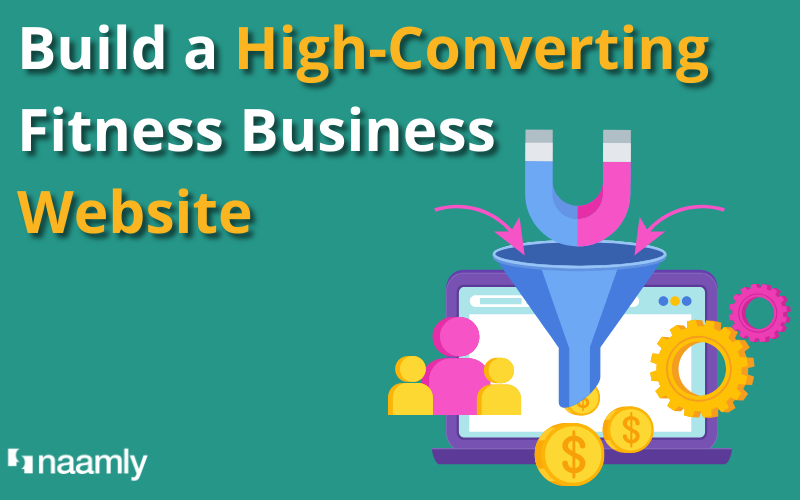A compelling online presence is crucial for the success of any fitness business, and a high-converting fitness business website plays a pivotal role in that essential formula.
It helps you attract prospects, get them into your communications system, and establishes your values and credibility in a hyper-competitive industry.
As one of our web design collaborators, 321goproject.com, says, “Marketing trends come and go – they’re enticing but temporary. What remains is your website, the heart of your digital presence.”

Your fitness business website needs to draw traffic, nurture leads, provide crucial information, and even put your potential clients in touch with you. You want to be clear about what your business does, who it’s for, and how they can connect.
But don’t worry. There’s no need to feel overwhelmed. We’re here to lay out the elements needed to create a website that not only showcases your unique fitness expertise but also converts visitors into loyal customers.
1. What Makes You Special
Before you start, get clear about your brand’s definition and selling point. What sets it apart from the competition? Is it your personalized training programs, cutting-edge equipment, or a unique fitness philosophy?
Knowing this will guide the design and content of your fitness business website, helping you communicate a compelling message to your target audience.
2. Keep the Design User Friendly
You don’t need to bring a lot of razzle-dazzle design to your site. You want it to be user-friendly, clean, and easy to navigate.
Any out-of-the-box design software, or a good designer, will make sure it’s responsive, meaning it looks good on smartphones and other devices, since a huge portion of your audience will find you while away from their desks.
(If you’re not sure, be sure to check it on your own phone and tablet!)

3. Choose Good Photos
The word “good” has two meanings here. First, the images need to show the type of client you’re trying to attract. Second, the photos need to be high-resolution, not blurry or pixelated.
You don’t have to spend a fortune on a professional photographer to ensure the appropriate quality. Same with videos, if you choose to use them.
4. Make the Homepage Engaging
The homepage should instantly state your purpose, capture visitors’ attention, and encourage them to explore further. Use a call-to-action (CTA) that directs users to take the next step, whether it’s scheduling a consultation, signing up for a trial class, or exploring your services.
Use a chatbot so visitors can interact right away.
Offer a free “lead magnet” to get them on your email list and into your communications system to continue nurturing them into members. (Read more: “Fitness Email Marketing Tips To Maximize Conversions.”)
5. Include the Basics on Your Fitness Business Website
What’s your address? What town are you in?
Seriously! It’s easy to forget when you’re so excited about your content and messages.
Don’t forget your phone number, operating hours, and a statement of purpose, like, “We help busy moms in their 20s stay fit,” or, “We train elite athletes to gain that extra 1% competitive edge.”
Link to your social media channels like Facebook, Instagram and YouTube, and encourage people to follow you there. You want to create a vibrant ecosystem of communications including your website, email newsletters, and social media.
6. Optimize for Search Engines (SEO)
Users rely on web searches to find businesses online, so your fitness business website needs to be optimized for search engines like Google and Yahoo.
Make sure your content, urls, and meta-tags are loaded with relevant keywords and phrases woven into them. Post fresh, relevant, and keyword-rich blog articles to keep satisfying the SEO beast on an ongoing basis.

7. Showcase Your Services
Clearly outline the range of services your fitness business offers on your fitness business website. Don’t assume anyone knows what you do – or what your abbreviations and jargon mean.
Whether it’s personal training, group classes, nutrition counseling, or specialty programs, provide detailed descriptions and any special promotions, a scheduling tool so they can book their first visit, and success stories that focus on the clients.
8. Use Strong, Clear Calls-to-Action (CTAs):
U several calls-to-action prompting visitors to schedule a consultation, sign up for a trial session, or subscribe to your newsletter. All your CTAs should be clear, compelling, and strategically located throughout your site.
9. Keep a Fresh Blog
A vibrant blog is great for SEO, as we mentioned. But there are more reasons to keep it fresh.
Your blog shows your values and personality in action. It lets visitors get to see more of what you’re about and whether yours is the right fitness business for them. The best blog posts are not salesy – instead, they position you as a resource.

10. Be Realistic
A high-converting fitness business website doesn’t mean that countless people will land on your page and instantly sign up. So, have realistic expectations.
A website is a basic component of business communications in today’s world, a digital storefront for your business. So, keep it welcoming, sharp, and useful. It draws traffic, gains leads you can nurture, and lets you establish your reason for being. That’s all super-important.
In conclusion, remember to be clear above all else. You don’t need to be too clever, flashy or trendy. Focus on getting visitors who will then enter your marketing system so you can keep communicating with them and nurture them into clients.
You might want to invest in a professional web designer or try creating your own site using one of the leading DIY tools. Either way, remember that you don’t have to reinvent the wheel to have a powerful site that will help you grow.

Embrace the digital landscape and put it to good use for your business. Learn more by enrolling in our Naamly Online University Newsletter.

